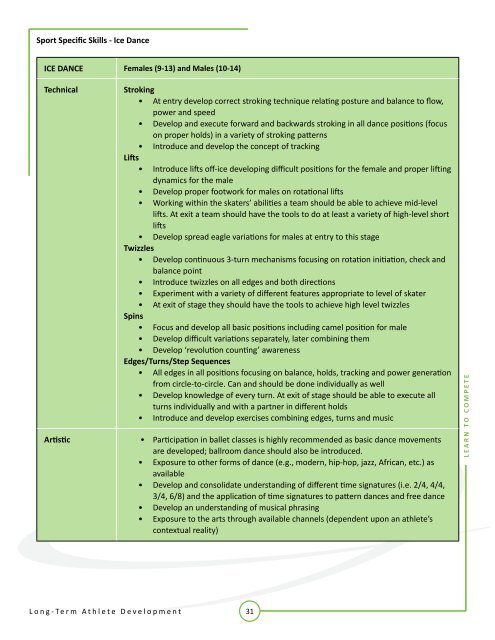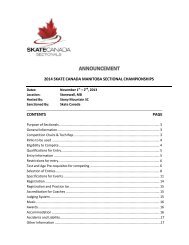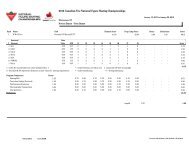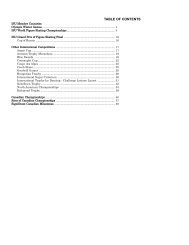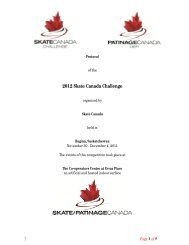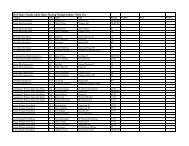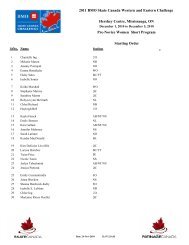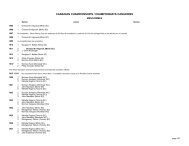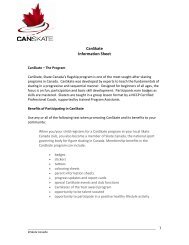LONG-TERM ATHLETE DEVELOPMENT - Skate Canada
LONG-TERM ATHLETE DEVELOPMENT - Skate Canada
LONG-TERM ATHLETE DEVELOPMENT - Skate Canada
Create successful ePaper yourself
Turn your PDF publications into a flip-book with our unique Google optimized e-Paper software.
Sport Specific Skills - Ice Dance<br />
ICE DANCE Females (9-13) and Males (10-14)<br />
L o n g - Te r m A t h l e t e D e v e l o p m e n t<br />
865 Sheord Road, Ottawa, Ontario K1J 1H9<br />
Phone 613.747.1007 I Toll Free 1.888.747.2372 I Fax 613.748.5718 I Toll Free Fax 1.877.211.2372<br />
Technical Stroking<br />
• At entry develop correct stroking technique relating posture and balance to flow,<br />
power and speed<br />
• Develop and execute forward and backwards stroking in all dance positions (focus<br />
on proper holds) in a variety of stroking patterns<br />
• Introduce and develop the concept of tracking<br />
Lifts<br />
• Introduce lifts off-ice developing difficult positions for the female and proper lifting<br />
dynamics for the male<br />
• Develop proper footwork for males on rotational lifts<br />
• Working within the skaters’ abilities a team should be able to achieve mid-level<br />
lifts. At exit a team should have the tools to do at least a variety of high-level short<br />
lifts<br />
• Develop spread eagle variations for males at entry to this stage<br />
Twizzles<br />
• Develop continuous 3-turn mechanisms focusing on rotation initiation, check and<br />
balance point<br />
• Introduce twizzles on all edges and both directions<br />
• Experiment with a variety of different features appropriate to level of skater<br />
• At exit of stage they should have the tools to achieve high level twizzles<br />
Spins<br />
• Focus and develop all basic positions including camel position for male<br />
• Develop difficult variations separately, later combining them<br />
• Develop ‘revolution counting’ awareness<br />
Edges/Turns/Step Sequences<br />
• All edges in all positions focusing on balance, holds, tracking and power generation<br />
from circle-to-circle. Can and should be done individually as well<br />
• Develop knowledge of every turn. At exit of stage should be able to execute all<br />
turns individually and with a partner in different holds<br />
• Introduce and develop exercises combining edges, turns and music<br />
Artistic • Participation in ballet classes is highly recommended as basic dance movements<br />
are developed; ballroom dance should also be introduced.<br />
• Exposure to other forms of dance (e.g., modern, hip-hop, jazz, African, etc.) as<br />
available<br />
• Develop and consolidate understanding of different time signatures (i.e. 2/4, 4/4,<br />
3/4, 6/8) and the application of time signatures to pattern dances and free dance<br />
• Develop an understanding of musical phrasing<br />
• Exposure to the arts through available channels (dependent upon an athlete’s<br />
contextual reality)<br />
31<br />
L E A R N T O C O M P E T E


